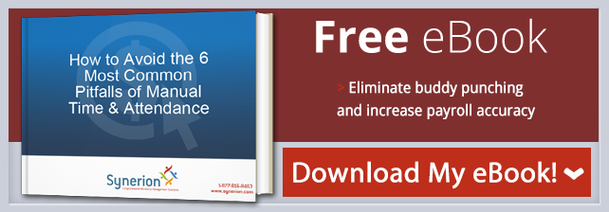Synerion Blog
How to Address Employee Fatigue
 With decreasing profits and increasing costs, businesses are always looking for ways to cut back. Sadly, that solution has sometimes meant layoffs and more often meant losing employees through attrition. While this may keep companies afloat, it also exhausts employees. Employee fatigue can seriously affect worker productivity, satisfaction, and morale. Address employee fatigue in your workplace to combat its negative effects.
With decreasing profits and increasing costs, businesses are always looking for ways to cut back. Sadly, that solution has sometimes meant layoffs and more often meant losing employees through attrition. While this may keep companies afloat, it also exhausts employees. Employee fatigue can seriously affect worker productivity, satisfaction, and morale. Address employee fatigue in your workplace to combat its negative effects.
Two Days Off
Overtime may be a necessity and you've probably noticed some employees jumping at the extra hours. Whether they're building a nest egg for a new home or paying for dependent expenses, employers sometimes need to step in to care for their employees. One way employers can help address employee fatigue is ensuring every single employee gets two days off per week. This allows employees adequate time to recharge and connect with their family. While overtime may provide businesses with manpower, it eats at employee energy. Require two days off for each employee every week.
Keep Lunches Out of the Office
Labor laws require employers to allow employees time for lunch, but a surprising number of employees don't take it. In fact, less than 20 percent of employees take their lunch break with many working at their desk through lunch or spending just minutes eating their meal and then returning to work. Breaks are needed not only for legal reasons but also to prevent employee fatigue. Workers who receive breaks are less prone to error and work more effectively. Stepping away from the office can produce new ideas and increase energy. Don't let employees work through their lunches. Make your employees take some time away from work during lunch.
Allow Flexibility
Addressing employee fatigue doesn't require an expensive roll-out or big initiative. By allowing flexibility, employers can create a more harmonious workplace and employees can reduce their chances of burn out. When possible, give employees flexibility in their schedules. Allow early bird employees to clock in thirty minutes earlier. If employees need to drop their children off in the morning, push back their start time to allow them more time in the mornings. Even fifteen minutes can turn a stressful morning into a more relaxing day. Work with your employees to adjust schedules to accommodate both work and personal preference to decrease employee fatigue.
Use Teamwork
Even with lower staffing levels, work doesn't need to get overwhelming. When a single employee is solely responsible for a task, productivity and workflow can suffer when that employee retires, quits, or goes on vacation. Teamwork is a simple way to reduce employee fatigue and keep productivity in check. Make sure that all positions and tasks have a back-up. Whether it's a co-worker or a manager, by giving employees someone else to rely on when workload increases, you can reduce fatigue.
Fuel Employees for Success
If your workplace is filled with sugary treats and vending food fare, you may have satisfied workers but that energy is short-lived. The afternoon sugar crash or morning donut binge hurts more than just waistlines, it can also reduce morale and increase fatigue. Remove sugary and carb-laden foods from your business and instead offer fresh fruits, nuts, and protein-packed snacks. By giving your employees healthier snack alternatives, you promote health and also reduce fatigue.
Employee fatigue has serious ramifications for employers if it's not addressed. It can destroy morale, lower productivity, and lead to employees leaving the company. Thankfully, employers can take some small steps to prevent it. Ensuring that employees have adequate time away from work, snack choices that limit sugar crashes and use teamwork to avoid burnout.

